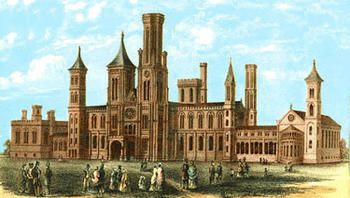



Establishment

Congressional Debates

Another decade of debate passed, however, before the Smithsonian was actually established. Congressmen, educators, researchers, social reformers, and the general public all voiced opinions as to what they believed Smithson had meant by “the increase and diffusion of knowledge." Initially most Americans assumed that Smithson intended to found a university, so the debates centered on what type of school. Gradually other ideas were introduced—an observatory, a scientific research institute, a national library, a publishing house, or a museum. The Smithsonian’s enabling act was a compromise among these ideas, leaving out only the university.
Act of Organization
Smithsonian Secretaries
The Secretary of the Smithsonian is its chief executive officer. There have been 13 secretaries who have led the Smithsonian since 1846.
Joseph Henry (1797–1878), served 1846 to 1878
Spencer Fullerton Baird (1823–1887), served 1878 to 1887
Samuel Pierpont Langley (1834–1906), served 1887 to 1906
Charles Doolittle Walcott (1850–1927), served 1907 to 1927
Charles Greeley Abbot (1872-1973), served 1928 to 1944
Alexander Wetmore (1886–1978), served 1944 to 1952
Leonard Carmichael (1898–1973), served 1953 to 1964
S. Dillon Ripley (1913–2001), served 1964 to 1984
Robert McCormick Adams (1926–2018), served 1984 to 1993
I. Michael Heyman (1930–2011), served 1993 to 1999
Lawrence M. Small (1941–), served 2000 to 2007
G. Wayne Clough (1941–), served 2008 to 2014
David Skorton (1949-), served 2015 to 2019
Lonnie G. Bunch III (1952–), serving since 2019



